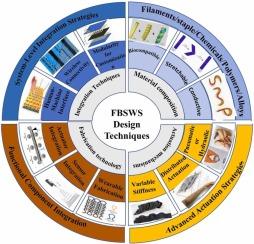Fabrication techniques and design considerations for fabric-based wearable soft systems and actuators
IF 4.9
3区 工程技术
Q2 ENGINEERING, ELECTRICAL & ELECTRONIC
引用次数: 0
Abstract
Fabric-Based Soft Wearable Systems (FBSWS) have emerged as a transformative technology for motion tracking, offering exceptional adaptability, non-invasiveness, and versatility. With growing applications in clinical assessment, sports performance analysis, and motion capture systems, FBSWS holds significant potential for real-world implementation. However, its broader adoption is hindered by challenges such as limited tracking precision, material stability, and reproducibility in fabrication. This review systematically examines state-of-the-art FBSWS systems, covering multi-dimensional design approaches, including 1-dimensional (fiber/yarn), 2-dimensional (fabric), and 3-dimensional (textile-integrated) configurations. Fabrication techniques such as coating, electrospinning, chemical deposition, knitting, weaving, and lamination are critically analyzed, focusing on their structural performance, responsiveness, and scalability. The review explores FBSWS applications in wearable health monitoring, rehabilitation, and interactive textiles, evaluating tracking methodologies, material properties, and performance metrics. Key advantages and limitations in practical deployment scenarios are discussed, emphasizing the need for improved precision, material durability, and reproducible fabrication strategies. Finally, future directions highlight advanced experimental designs, such as hybrid sensing systems and multi-functional material compositions that integrate conductivity and responsiveness for enhanced tracking accuracy. Emphasis is placed on scalable fabrication methodologies to enhance real-world applicability, reliability, and performance in movement tracking and related fields.

基于织物的可穿戴软系统和执行器的制造技术和设计考虑
基于织物的软可穿戴系统(FBSWS)已经成为一种革命性的运动跟踪技术,具有卓越的适应性、非侵入性和多功能性。随着临床评估、运动表现分析和动作捕捉系统的应用越来越多,FBSWS在现实世界中的应用潜力巨大。然而,它的广泛采用受到诸如有限的跟踪精度、材料稳定性和制造可重复性等挑战的阻碍。本综述系统地考察了最先进的FBSWS系统,涵盖了多维设计方法,包括一维(纤维/纱线)、二维(织物)和三维(纺织品集成)配置。制造技术,如涂层,静电纺丝,化学沉积,针织,编织和层压进行了严格的分析,重点是他们的结构性能,响应能力和可扩展性。本文探讨了FBSWS在可穿戴健康监测、康复和交互式纺织品中的应用,评估了跟踪方法、材料特性和性能指标。讨论了实际部署场景中的关键优势和限制,强调需要提高精度,材料耐久性和可重复性制造策略。最后,未来的方向是强调先进的实验设计,如混合传感系统和多功能材料组合,集成了导电性和响应性,以提高跟踪精度。重点放在可扩展的制造方法,以提高现实世界的适用性,可靠性和性能在运动跟踪和相关领域。
本文章由计算机程序翻译,如有差异,请以英文原文为准。
求助全文
约1分钟内获得全文
求助全文
来源期刊

Sensors and Actuators A-physical
工程技术-工程:电子与电气
CiteScore
8.10
自引率
6.50%
发文量
630
审稿时长
49 days
期刊介绍:
Sensors and Actuators A: Physical brings together multidisciplinary interests in one journal entirely devoted to disseminating information on all aspects of research and development of solid-state devices for transducing physical signals. Sensors and Actuators A: Physical regularly publishes original papers, letters to the Editors and from time to time invited review articles within the following device areas:
• Fundamentals and Physics, such as: classification of effects, physical effects, measurement theory, modelling of sensors, measurement standards, measurement errors, units and constants, time and frequency measurement. Modeling papers should bring new modeling techniques to the field and be supported by experimental results.
• Materials and their Processing, such as: piezoelectric materials, polymers, metal oxides, III-V and II-VI semiconductors, thick and thin films, optical glass fibres, amorphous, polycrystalline and monocrystalline silicon.
• Optoelectronic sensors, such as: photovoltaic diodes, photoconductors, photodiodes, phototransistors, positron-sensitive photodetectors, optoisolators, photodiode arrays, charge-coupled devices, light-emitting diodes, injection lasers and liquid-crystal displays.
• Mechanical sensors, such as: metallic, thin-film and semiconductor strain gauges, diffused silicon pressure sensors, silicon accelerometers, solid-state displacement transducers, piezo junction devices, piezoelectric field-effect transducers (PiFETs), tunnel-diode strain sensors, surface acoustic wave devices, silicon micromechanical switches, solid-state flow meters and electronic flow controllers.
Etc...
 求助内容:
求助内容: 应助结果提醒方式:
应助结果提醒方式:


